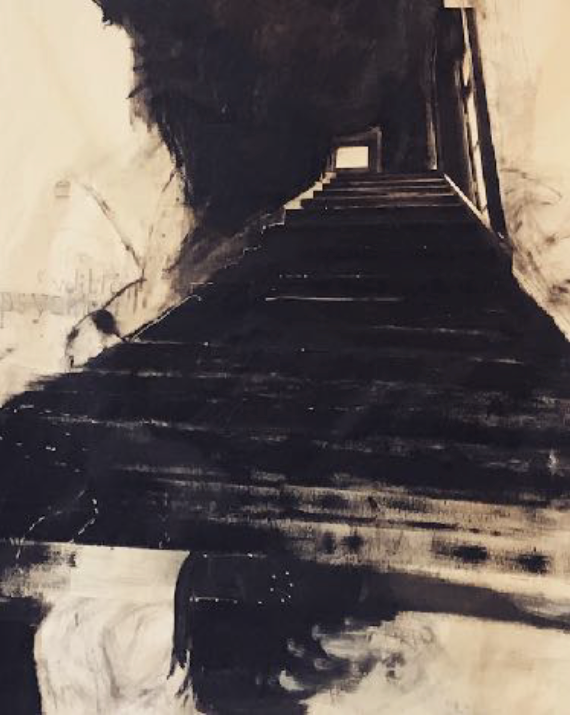Press
Sleepwalker
2023 Alumni Exhibition
New York Studio School
Mercedes Matter Award
By Alexi Worth
9/26/2023 Painter, Critic, Curator
"Cynthia Sparrenberger is not an artist I know, but what a pleasure the spiral drama of this is; the viewer gets to, like, fall headlong down these fucking stairs and die at the end in this little white rectangle…but the tone is beautiful, it's almost like two tones. Just a deep, deep, almost black, and white, and it feels kind of smudgy and so vertiginous and also delicate, like graphic but then there's all this space to it. And it's so perspectival… so architectural, with a little promising instability.”
You are Here
A Wayfinder’s Logbook
By John Seed
John Seed is a professor of art and art history at Mt. San Jacinto College in Southern California. He has written about art and artists for The Huffington Post, Art Ltd., and Hyperallergic.
Cynthia Sparrenberger’s recent paintings constitute a kind of visionary logbook. It records and describes unconscious images that Sparrenberger believes are “similar to flying over one’s own soul with a birds eye view of the terrain.” The terrain she is mapping, however, is psychological. These colorful topographies often resemble a vortex of wounds, forces, utterances and barriers: her work is a search and rescue mission to recover a threatened identity. Painting has served Sparrenberger as a way to document the devastating effects of alienation, misunderstandings and enmities within human relationships that separate people from each other.
“These colorful topographies often resemble a vortex of wounds, forces, utterances and barriers: her work is a search and rescue mission to recover a threatened identity. ”
Sparrenberger’s personal habit of note-taking has been important to the development of her paintings:
“During the crazy transitions in my life, I would keep little calendar books and write down simple things I did every day in order to remember that particular day and distinguish it from other days. I would realize that the limbo I was in would all run together, and that there would be years that I could not even remember. I would write out fears and frustrations in my paintings and then write over and over them again and again to develop a design that would be invisible to any other eye but my own. Even so they remain beneath the surface of my work, integral truths that are forever there.”
Although Sparrenberger’s imagery is most often abstract, her paintings often include representational elements that appear like revelations: which they in fact are. One recurring image is an oval-headed green alien who peers from behind a welter of semi-abstract forms in her painting After Happily Ever, which Sparrenberger describes as a “deconstructed fairy tale.” This green alien with his one sad eye, is at least an identifiable character, an avatar who assesses the unconscious debris.
Devoting herself to drawing for over a year resulted in a bound sketchbook titled “Underground: A Dark Beauty,” Sparrenberger dove into what she knows to be a “sea of alienation and isolation” to search for imagery. When she next returned to large-scale painting, she found herself creating the varied and often violent works. “I remember coming to a realization that the circumstances of my previous life felt something like being in a tornado. Making art was like entering a long dark tunnel. When I eventually re-surfaced, all the givens of my life had been removed. I had found my way back to a new beginning through my work.”
Informed by the smaller sketchbook images, a pictorial psychological topography emerged. It is through these paintings that she has re-awakened her voice. Sparrenberger envisions some of her works as cave paintings, by virtue of their primal impulses, and their layers upon layers of incised marks, not unlike carvings in trees and park benches and walls. Handprints are another reoccurring image, denoting the importance and preservation of singular identity.
“As dark and difficult as Sparrenberger’s works may be, they certainly contain brilliant patches of light and glimpses of human revelation.”
In Sparrenberger’s words: “My themes include alienation, misunderstandings, isolation and the loss of personal identity. These things happen to one individual at a time, but then also become collective experiences that are spread across an entire society.”
One painting, “Exodus” sparked by the reference to Jacob’s ladder, alludes to the testament of human transcendence, even in violent circumstances. The painting’s dreamlike imagery features two white figures — they resemble angelic rabbits — who float free of a field of incomprehensible text and tiny houses. They reach upwards into a rough, dark sky that holds a few sad stars and a single red planet. “Exodus” is a jarring and dreamlike painting that suggests a strange collision of adult pain and childlike yearning.
Another canvas, titled “Catastrophic,” contains a Pierrot-like figure with a large orange hand who leans backwards as a looming figure above prepares to launch a large stone orb in his direction. The work’s colors— black, white and grey with a hint of steely blue sky— give a feeling of wintry isolation.
Art can offer individuals a path to reconciliation with the world. These emotionally symbolic paintings are a way to communicate, through one individual’s struggle, the similar struggles of many. As dark and difficult as Sparrenberger’s works may be, they certainly contain brilliant patches of light and glimpses of human revelation.
